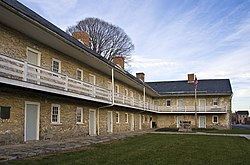
Gallaudet University is a private federally chartered university in Washington, D.C., for the education of the deaf and hard of hearing. It was founded in 1864 as a grammar school for both deaf and blind children. It was the first school for the advanced education of the deaf and hard of hearing in the world and remains the only higher education institution in which all programs and services are specifically designed to accommodate deaf and hard of hearing students. Hearing students are admitted to the graduate school and a small number are also admitted as undergraduates each year. The university was named after Thomas Hopkins Gallaudet, a notable figure in the advancement of deaf education.
The Louisiana School for the Deaf is a state school for deaf and hard-of-hearing students in Louisiana, located in Baton Rouge, the state capital. It was established in 1852 as a joint school for blind students. In 1860, its first purpose-built facility was completed and admired as an elegant monument to philanthropy. The schools were divided in 1898, and in 1908, Louisiana School for the Deaf was renamed.

The Florida School for the Deaf and the Blind (FSDB) is a state-supported boarding school for deaf and blind children established in 1885, in St. Augustine, Florida, United States.
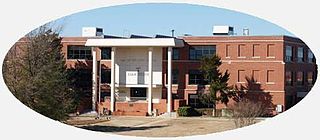
Oklahoma School for the Deaf (OSD) is a public residential school for the deaf and hard of hearing students ages 2 through 18. The school teaches K-12 students in Sulphur, Oklahoma, United States.

The Kentucky School for the Deaf (KSD), located in Danville, Kentucky, United States, is a school that provides education to deaf and hard-of-hearing children from elementary through high school levels. Founded in 1823, it was the first school for the deaf west of the Allegheny Mountains. Jacobs Hall, its oldest surviving building, was designated a National Historic Landmark in recognition of this history.

The Ohio School for the Deaf is a school located in Columbus, Ohio. It is run by the Ohio Department of Education for deaf and hard-of-hearing students across Ohio. It was established on October 16, 1829, making it the fifth oldest residential school in the country. OSD is the only publicly funded residential school for the deaf in Ohio.

The California School for the Blind is a public educational institution for blind children, K-12, located in Fremont, California. Its campus is located next to the California School for the Deaf.

The Virginia School for the Deaf and the Blind, located in Staunton, Virginia, United States, is an institution for educating deaf and blind children, first established in 1839 by an act of the Virginia General Assembly. The school accepts children aged between 2 and 22 and provides residential accommodation for those students aged 5 and over who live outside a 35-mile (56 km) radius of the school
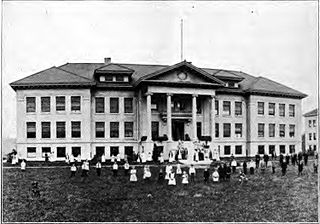
Oregon School for the Deaf (OSD) is a state-funded school in Salem, Oregon, United States. It serves deaf and hard of hearing students from kindergarten through high school, and up to 18 years of age.

The Minnesota State Academy for the Deaf (MSAD) is a public residential school serving deaf children in Minnesota, United States. It is one of two Minnesota State Academies in Faribault and operated by the state for particular student populations.
The Tennessee Schools for the Deaf (TSD) is a state-operated residential and day school for deaf and hard-of-hearing students who reside in the state of Tennessee ranging from pre-kindergarten to grade 12 and also includes a Comprehensive Adult Program. The main campus is located in Knoxville, Tennessee within the historic Island Home Park neighborhood. There are two additional campuses serving elementary students in Nashville and Jackson.
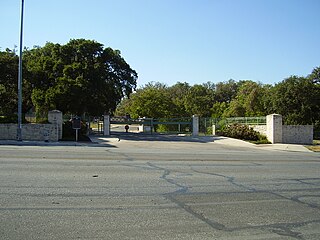
Texas School for the Deaf (TSD) is a state-operated primary and secondary school for deaf children in Austin, Texas. Opened in 1857 "in an old frame house, three log cabins, and a smokehouse", it is the oldest continually-operated public school in Texas. The school struggled under inadequate funding during the American Civil War, and its aftermath, with the students eating food that they grew themselves on the school farm. In 1951 the State Board of Education assumed oversight of the school.

The Pennsylvania School for the Deaf is the third-oldest school of its kind in the United States. Its founder, David G. Seixas (1788–1864), was a Philadelphia crockery maker-dealer who became concerned with the plight of impoverished deaf children who he observed on the city's streets. The current school building is listed by the National Register of Historic Places, and two former campuses are similarly recognized.

The North Carolina School for the Deaf (NCSD) is a state-supported residential school for deaf children established in 1894, in Morganton, North Carolina, US.
The Mississippi School for the Deaf (MSD) is a school for the deaf and hard of hearing in Jackson, Mississippi accredited by the Southern Association of Colleges and Schools (SACS). It offers elementary and secondary education (K-12), covering students from pre-kindergarten to twelfth grade.
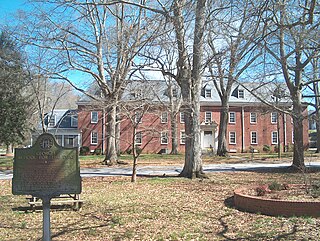
Georgia School for the Deaf (GSD) is a public residential school for the deaf. GSD provides comprehensive education and services to deaf and hard-of-hearing students between the ages of three and twenty-two. Located in Cave Spring, Georgia, United States, the school offers day and residential programs which meet the academic, social and physical needs of students in a bilingual environment. It was established in 1846 and is one of three public state schools operated by the Georgia Department of Education.
Iowa School for the Deaf is a pre-K to 12th grade school for deaf and hard-of-hearing students located in Council Bluffs, Iowa. It serves students who live in Iowa and Nebraska.

The Alabama Institute for Deaf and Blind (AIDB) is the world’s most comprehensive education, rehabilitation and service program serving individuals of all ages who are deaf, blind, deafblind and multidisabled. It is operated by the U.S. state of Alabama in the city of Talladega. The current institution includes the Alabama School for the Deaf, the Alabama School for the Blind, and the Helen Keller School of Alabama, named for Alabamian Helen Keller, which serves children who are both deaf and blind. E. H. Gentry Facility provides vocational training for adult students, and the institution offers employment through its Alabama Industries for the Blind facilities in Talladega and Birmingham. AIDB has regional centers in Birmingham, Decatur, Dothan, Huntsville, Mobile, Montgomery, Opelika, Shoals, Talladega, and Tuscaloosa. AIDB currently serves over 36,000 residents from all 67 counties of the state.
Kendall Demonstration Elementary School (KDES) is a private day school serving deaf and hard of hearing students from birth through grade 8 on the campus of Gallaudet University in the Trinidad neighborhood of Washington, D.C. Alongside Model Secondary School for the Deaf, it is a federally funded, tuition-free demonstration school administered by the Laurent Clerc National Deaf Education Center at Gallaudet University.
Michigan School for the Deaf is a public K–12 school for deaf children in Flint, Michigan. It is under the Michigan State Board of Education.


